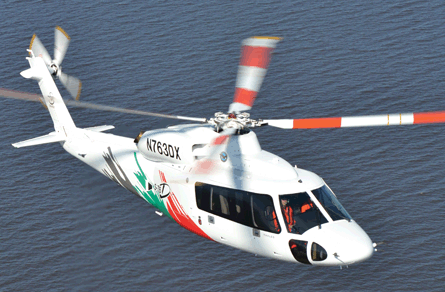With engine troubles behind it, Sikorsky is in the home stretch for completing certification and first deliveries of its new S-76D medium-class helicopter, albeit four years later than originally expected.
Dan Hunter, director of programmes for Sikorsky Global Helicopters, said he expected to deliver the first helicopter in September. Hunter was unable to identify the customer, but said it was a corporate operator in the Northeast corridor of the US or one in the Middle East, two areas where interest in the twin-engine helicopter is strong. Advanced features of the S-76D, which replaces the S-76C++ in the Sikorsky turbine helicopter line, include a composite main rotor, more fuel efficient and powerful Pratt & Whitney Canada PW210s turboshaft engines, a Thales integrated flightdeck and advanced safety features such as active vibration control. Sikorsky has not yet revealed the price for S-76D.
 |
|---|
© John Croft/Flightglobal Sikorsky plans to build 24 S-76Ds next year and 'deliver them all' |
The company is building the final C++, serial number 818. Hunter said almost 800 S-76 models continue to fly and have accumulated a total of 5.6 million flight hours. Like the C++, the S-76D will have a maximum cruise speed of 155kt (287km/h) and maximum gross weight of 5,307kg (11,700lb), at least initially.
"We stubbed our toe a little along the way," said Hunter of the delays.
The stubbing had largely to do with developmental problems on the S-76D's new engine, the PW210. The largest of the PW200 line of turboshaft engines to date, the PW210s produces a maximum continuous power of 1,070shp (798kW), a 25% increase over the Turbomeca Arriel 2S2 engines for the S-76C++, but with 4% lower specific fuel consumption. "The engine had a few issues getting great specific fuel consumption and power [at the same time]," Hunter said.
Hunter, who became director of programmes in September, previously led the company's maritime helicopter programmes and worked as chief engineer on the Boeing-Sikorsky Comanche attack helicopter for two years.
A significant engine delay involved the insufficient transient response at altitude, described as a "decoupling and re-coupling issue" during autorotation above 12,000ft (3,660m). "The fast acceleration schedule wasn't fast enough to meet the rotor demand," said Sikorsky test pilot Greg Barnes. The problem turned out to be related in part to the turboshaft engine's impeller (centrifugal compressor) design. Barnes said the problem was found during a test flight where both engines stalled while in a high hover. The pilot restarted the engines and the helicopter was landed safely.
After the incident, Pratt & Whitney Canada came up with a more "design tolerant" impeller and a quicker response T1 inlet temperature probe (part of the control system for the FADEC-equipped engine), but the S-76D schedule had been set back.
"It was a knock-on effect," said Hunter. "While we couldn't get to altitude because we needed an improved engine, we didn't learn as much as we needed to about the avionics." The Thales-built flightdeck, which includes provisions for a variety of next generation navigation, communications and surveillance functions, has not had similar growing pains.
With the engines now type certificated by Transport Canada and the US Federal Aviation Administration (FAA) in October and December, respectively, Sikorsky seems to be in control of its destiny as the three flight test aircraft set out to complete the final 300h in the initial certification programme. Hunter said the FAA has delegated about 80% of the authority needed to certificate the S-76D to Sikorsky through the Organization Designation Authorization process.
"I feel very confident in our schedule," he said. Of the 660h flight hours accumulated as of 6 December, about 80h have been logged as part of the certification programme, Barnes said. Hunter said Sikorsky is planning to build 24 aircraft next year and "intends to deliver them all". Steady state production will be 24-30 a year after that, he said, with a jump to as many as 36 a year possible "if there's a pop" in demand.
Source: Flight International
















